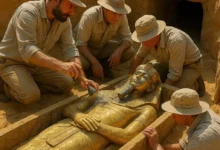“Hot News 23/3” The reason why the Egyptians were able to build the great pyramids has been found.

The Engineering Genius Behind Ancient Egyptian Monuments
The construction of ancient Egyptian monuments remains one of the most astonishing achievements in human history, showcasing the extraordinary precision, innovation, and architectural brilliance of one of the world’s greatest civilizations. These magnificent structures were not merely built—they were meticulously designed using advanced mathematical and engineering techniques that continue to baffle modern scientists and engineers.
The Great Pyramid of Giza: A Testament to Precision
One of the most iconic and enduring symbols of ancient Egyptian engineering prowess is the Great Pyramid of Giza. Built over 4,500 years ago for Pharaoh Khufu, this monumental structure still stands as one of the Seven Wonders of the Ancient World. What makes it particularly extraordinary is its near-perfect alignment with the cardinal points of the compass, demonstrating an advanced understanding of astronomy and geometry.
The pyramid originally stood at 146.6 meters (481 feet) and spanned 230 meters (756 feet) on each side. The precision in its construction is mind-blowing—each of the estimated 2.3 million limestone blocks, some weighing as much as 80 tons, was cut, transported, and placed with remarkable accuracy. Historians believe that the Egyptians used a sophisticated system of ramps, pulleys, and counterweights to move these massive stones into place, a feat that would be challenging even with today’s technology.
The Mathematics Behind the Marvel
The Egyptians were master mathematicians. They employed a unit of measurement known as the “cubit” (roughly 52.3 cm or 20.6 inches) to ensure uniformity in their structures. The construction of pyramids required precise calculations, and evidence suggests that they utilized the Pythagorean theorem—long before Pythagoras was even born—to establish right angles and ensure the stability of their monuments.
Moreover, the golden ratio (approximately 1.618), a mathematical proportion seen in many natural and artistic wonders, is believed to have influenced the pyramid’s design. Scholars speculate that this ratio contributed to the aesthetic harmony and structural resilience of the pyramid, further proving the Egyptians’ deep grasp of mathematical principles.
Celestial Alignments and Religious Significance
Egyptian monuments were not just feats of engineering; they were deeply intertwined with religious beliefs and cosmic principles. The pyramids were designed to align with significant celestial bodies, reinforcing the Egyptians’ belief in the afterlife and their connection to the gods. For example, shafts within the Great Pyramid are aligned with specific stars, possibly serving as pathways for the pharaoh’s soul to ascend to the heavens.
Temples and obelisks were similarly constructed with astronomical precision. The Karnak Temple complex, for instance, aligns with the winter solstice, allowing sunlight to penetrate its innermost sanctuaries on specific days of the year. This meticulous planning underscores the Egyptians’ advanced knowledge of the cosmos and its role in their religious and cultural life.
Innovations Beyond the Pyramids
While the pyramids are the most famous examples of Egyptian engineering, their innovation extended to a variety of structures, including massive temples, intricate tombs, towering obelisks, and even early forms of urban planning. They developed complex irrigation systems to manage the Nile’s floodwaters, ensuring agricultural prosperity and sustaining one of the longest-lasting civilizations in history.
The obelisks, some of which weighed over 300 tons, were quarried from single pieces of granite and transported across vast distances. How they managed this feat remains a subject of debate, but theories suggest they used a combination of sleds, water channels, and manpower to maneuver these towering monuments into place.
The Lasting Legacy
The ingenuity of ancient Egyptian architects and engineers has left an indelible mark on the world. Their mathematical precision, architectural brilliance, and innovative techniques continue to inspire modern architects, engineers, and scholars. The structures they built thousands of years ago still stand today, defying time and natural elements, a true testament to their unparalleled craftsmanship.
From the Great Pyramid of Giza to the grand temples of Luxor and Karnak, the legacy of ancient Egypt lives on in these awe-inspiring monuments. Their achievements remind us that even in the ancient world, human creativity, intelligence, and perseverance knew no bounds.
#AncientEgypt #Giza #Pyramids #EngineeringWonders #MathematicalGenius





